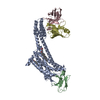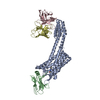+ データを開く
データを開く
- 基本情報
基本情報
| 登録情報 | データベース: PDB / ID: 8th4 | ||||||||||||||||||||||||
|---|---|---|---|---|---|---|---|---|---|---|---|---|---|---|---|---|---|---|---|---|---|---|---|---|---|
| タイトル | Structure of AT118-L Nanobody Antagonist in Complex with the Angiotensin II Type I Receptor and Losartan | ||||||||||||||||||||||||
 要素 要素 |
| ||||||||||||||||||||||||
 キーワード キーワード | SIGNALING PROTEIN/IMMUNE SYSTEM / G protein-coupled receptor / nanobody / SIGNALING PROTEIN-IMMUNE SYSTEM complex | ||||||||||||||||||||||||
| 機能・相同性 |  機能・相同性情報 機能・相同性情報angiotensin type I receptor activity / angiotensin type II receptor activity / phospholipase C-activating angiotensin-activated signaling pathway / regulation of renal sodium excretion / maintenance of blood vessel diameter homeostasis by renin-angiotensin / bradykinin receptor binding / renin-angiotensin regulation of aldosterone production / positive regulation of blood vessel endothelial cell proliferation involved in sprouting angiogenesis / positive regulation of cholesterol metabolic process / low-density lipoprotein particle remodeling ...angiotensin type I receptor activity / angiotensin type II receptor activity / phospholipase C-activating angiotensin-activated signaling pathway / regulation of renal sodium excretion / maintenance of blood vessel diameter homeostasis by renin-angiotensin / bradykinin receptor binding / renin-angiotensin regulation of aldosterone production / positive regulation of blood vessel endothelial cell proliferation involved in sprouting angiogenesis / positive regulation of cholesterol metabolic process / low-density lipoprotein particle remodeling / positive regulation of macrophage derived foam cell differentiation / regulation of systemic arterial blood pressure by renin-angiotensin / regulation of vasoconstriction / Rho protein signal transduction / Peptide ligand-binding receptors / blood vessel diameter maintenance / angiotensin-activated signaling pathway / cell chemotaxis / kidney development / regulation of cell growth / calcium-mediated signaling / electron transport chain / positive regulation of reactive oxygen species metabolic process / positive regulation of inflammatory response / Cargo recognition for clathrin-mediated endocytosis / Clathrin-mediated endocytosis / regulation of cell population proliferation / positive regulation of cytosolic calcium ion concentration / regulation of inflammatory response / phospholipase C-activating G protein-coupled receptor signaling pathway / G alpha (q) signalling events / periplasmic space / electron transfer activity / G protein-coupled receptor signaling pathway / iron ion binding / inflammatory response / protein heterodimerization activity / heme binding / symbiont entry into host cell / membrane / plasma membrane 類似検索 - 分子機能 | ||||||||||||||||||||||||
| 生物種 |  Homo sapiens (ヒト) Homo sapiens (ヒト) synthetic construct (人工物) | ||||||||||||||||||||||||
| 手法 | 電子顕微鏡法 / 単粒子再構成法 / クライオ電子顕微鏡法 / 解像度: 3.3 Å | ||||||||||||||||||||||||
 データ登録者 データ登録者 | Skiba, M.A. / Kruse, A.C. | ||||||||||||||||||||||||
| 資金援助 |  米国, 7件 米国, 7件
| ||||||||||||||||||||||||
 引用 引用 |  ジャーナル: Nat Chem Biol / 年: 2024 ジャーナル: Nat Chem Biol / 年: 2024タイトル: Antibodies expand the scope of angiotensin receptor pharmacology. 著者: Meredith A Skiba / Sarah M Sterling / Shaun Rawson / Shuhao Zhang / Huixin Xu / Haoran Jiang / Genevieve R Nemeth / Morgan S A Gilman / Joseph D Hurley / Pengxiang Shen / Dean P Staus / Jihee ...著者: Meredith A Skiba / Sarah M Sterling / Shaun Rawson / Shuhao Zhang / Huixin Xu / Haoran Jiang / Genevieve R Nemeth / Morgan S A Gilman / Joseph D Hurley / Pengxiang Shen / Dean P Staus / Jihee Kim / Conor McMahon / Maria K Lehtinen / Howard A Rockman / Patrick Barth / Laura M Wingler / Andrew C Kruse /   要旨: G-protein-coupled receptors (GPCRs) are key regulators of human physiology and are the targets of many small-molecule research compounds and therapeutic drugs. While most of these ligands bind to ...G-protein-coupled receptors (GPCRs) are key regulators of human physiology and are the targets of many small-molecule research compounds and therapeutic drugs. While most of these ligands bind to their target GPCR with high affinity, selectivity is often limited at the receptor, tissue and cellular levels. Antibodies have the potential to address these limitations but their properties as GPCR ligands remain poorly characterized. Here, using protein engineering, pharmacological assays and structural studies, we develop maternally selective heavy-chain-only antibody ('nanobody') antagonists against the angiotensin II type I receptor and uncover the unusual molecular basis of their receptor antagonism. We further show that our nanobodies can simultaneously bind to angiotensin II type I receptor with specific small-molecule antagonists and demonstrate that ligand selectivity can be readily tuned. Our work illustrates that antibody fragments can exhibit rich and evolvable pharmacology, attesting to their potential as next-generation GPCR modulators. | ||||||||||||||||||||||||
| 履歴 |
|
- 構造の表示
構造の表示
| 構造ビューア | 分子:  Molmil Molmil Jmol/JSmol Jmol/JSmol |
|---|
- ダウンロードとリンク
ダウンロードとリンク
- ダウンロード
ダウンロード
| PDBx/mmCIF形式 |  8th4.cif.gz 8th4.cif.gz | 196 KB | 表示 |  PDBx/mmCIF形式 PDBx/mmCIF形式 |
|---|---|---|---|---|
| PDB形式 |  pdb8th4.ent.gz pdb8th4.ent.gz | 120.2 KB | 表示 |  PDB形式 PDB形式 |
| PDBx/mmJSON形式 |  8th4.json.gz 8th4.json.gz | ツリー表示 |  PDBx/mmJSON形式 PDBx/mmJSON形式 | |
| その他 |  その他のダウンロード その他のダウンロード |
-検証レポート
| 文書・要旨 |  8th4_validation.pdf.gz 8th4_validation.pdf.gz | 1.5 MB | 表示 |  wwPDB検証レポート wwPDB検証レポート |
|---|---|---|---|---|
| 文書・詳細版 |  8th4_full_validation.pdf.gz 8th4_full_validation.pdf.gz | 1.5 MB | 表示 | |
| XML形式データ |  8th4_validation.xml.gz 8th4_validation.xml.gz | 34.7 KB | 表示 | |
| CIF形式データ |  8th4_validation.cif.gz 8th4_validation.cif.gz | 48.8 KB | 表示 | |
| アーカイブディレクトリ |  https://data.pdbj.org/pub/pdb/validation_reports/th/8th4 https://data.pdbj.org/pub/pdb/validation_reports/th/8th4 ftp://data.pdbj.org/pub/pdb/validation_reports/th/8th4 ftp://data.pdbj.org/pub/pdb/validation_reports/th/8th4 | HTTPS FTP |
-関連構造データ
| 関連構造データ |  41249MC  8th3C M: このデータのモデリングに利用したマップデータ C: 同じ文献を引用 ( |
|---|---|
| 類似構造データ | 類似検索 - 機能・相同性  F&H 検索 F&H 検索 |
- リンク
リンク
- 集合体
集合体
| 登録構造単位 | 
|
|---|---|
| 1 |
|
- 要素
要素
| #1: タンパク質 | 分子量: 49501.059 Da / 分子数: 1 / 由来タイプ: 組換発現 由来: (組換発現)  Homo sapiens (ヒト), (組換発現) Homo sapiens (ヒト), (組換発現)  遺伝子: AGTR1, AGTR1A, AGTR1B, AT2R1, AT2R1B, cybC / Cell (発現宿主): Expi293 Tet-R / 発現宿主:  Homo sapiens (ヒト) / 参照: UniProt: P30556, UniProt: P0ABE7 Homo sapiens (ヒト) / 参照: UniProt: P30556, UniProt: P0ABE7 |
|---|---|
| #2: 抗体 | 分子量: 24539.314 Da / 分子数: 1 / 由来タイプ: 組換発現 / 由来: (組換発現) synthetic construct (人工物) / 発現宿主:  Homo sapiens (ヒト) Homo sapiens (ヒト) |
| #3: 抗体 | 分子量: 23541.164 Da / 分子数: 1 / 由来タイプ: 組換発現 / 由来: (組換発現) synthetic construct (人工物) / 発現宿主:  Homo sapiens (ヒト) Homo sapiens (ヒト) |
| #4: 抗体 | 分子量: 15345.063 Da / 分子数: 1 / 由来タイプ: 組換発現 / 由来: (組換発現) synthetic construct (人工物) / 発現宿主:  |
| #5: 化合物 | ChemComp-LSN / [ |
| 研究の焦点であるリガンドがあるか | N |
| Has protein modification | Y |
-実験情報
-実験
| 実験 | 手法: 電子顕微鏡法 |
|---|---|
| EM実験 | 試料の集合状態: PARTICLE / 3次元再構成法: 単粒子再構成法 |
- 試料調製
試料調製
| 構成要素 | 名称: AT118-L Nanobody Antagonist in Complex with the Angiotensin II Type I Receptor BRIL Fusion protein, Anti-BRIL Fab, Anti-Fab Nanobody, and Losartan タイプ: COMPLEX / Entity ID: #1-#4 / 由来: MULTIPLE SOURCES |
|---|---|
| 分子量 | 実験値: NO |
| 由来(天然) | 生物種:  Homo sapiens (ヒト) Homo sapiens (ヒト) |
| 由来(組換発現) | 生物種:  Homo sapiens (ヒト) / 細胞: Expi293 Tet-R Homo sapiens (ヒト) / 細胞: Expi293 Tet-R |
| 緩衝液 | pH: 7.4 詳細: 20 mM HEPES, pH 7.4, 100 mM NaCl, 0.05% GDN, 0.005% CHS |
| 試料 | 濃度: 7 mg/ml / 包埋: NO / シャドウイング: NO / 染色: NO / 凍結: YES |
| 試料支持 | グリッドの材料: GOLD / グリッドのサイズ: 300 divisions/in. / グリッドのタイプ: UltrAuFoil R1.2/1.3 |
| 急速凍結 | 装置: FEI VITROBOT MARK IV / 凍結剤: ETHANE / 湿度: 100 % / 凍結前の試料温度: 293 K |
- 電子顕微鏡撮影
電子顕微鏡撮影
| 実験機器 |  モデル: Titan Krios / 画像提供: FEI Company |
|---|---|
| 顕微鏡 | モデル: FEI TITAN KRIOS |
| 電子銃 | 電子線源:  FIELD EMISSION GUN / 加速電圧: 300 kV / 照射モード: FLOOD BEAM FIELD EMISSION GUN / 加速電圧: 300 kV / 照射モード: FLOOD BEAM |
| 電子レンズ | モード: BRIGHT FIELD / 最大 デフォーカス(公称値): 1800 nm / 最小 デフォーカス(公称値): 800 nm |
| 試料ホルダ | 試料ホルダーモデル: FEI TITAN KRIOS AUTOGRID HOLDER |
| 撮影 | 電子線照射量: 64.1 e/Å2 フィルム・検出器のモデル: GATAN K3 BIOQUANTUM (6k x 4k) |
- 解析
解析
| EMソフトウェア |
| ||||||||||||||||||||||||||||||||
|---|---|---|---|---|---|---|---|---|---|---|---|---|---|---|---|---|---|---|---|---|---|---|---|---|---|---|---|---|---|---|---|---|---|
| CTF補正 | タイプ: PHASE FLIPPING AND AMPLITUDE CORRECTION | ||||||||||||||||||||||||||||||||
| 粒子像の選択 | 選択した粒子像数: 405950 | ||||||||||||||||||||||||||||||||
| 対称性 | 点対称性: C1 (非対称) | ||||||||||||||||||||||||||||||||
| 3次元再構成 | 解像度: 3.3 Å / 解像度の算出法: FSC 0.143 CUT-OFF / 粒子像の数: 238621 / 対称性のタイプ: POINT | ||||||||||||||||||||||||||||||||
| 精密化 | 交差検証法: NONE 立体化学のターゲット値: GeoStd + Monomer Library + CDL v1.2 | ||||||||||||||||||||||||||||||||
| 原子変位パラメータ | Biso mean: 83.12 Å2 | ||||||||||||||||||||||||||||||||
| 拘束条件 |
|
 ムービー
ムービー コントローラー
コントローラー




 PDBj
PDBj



















